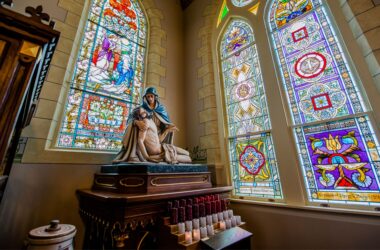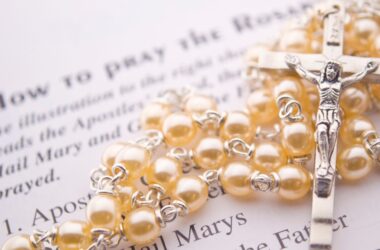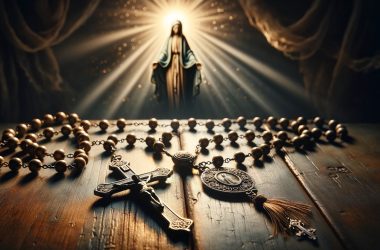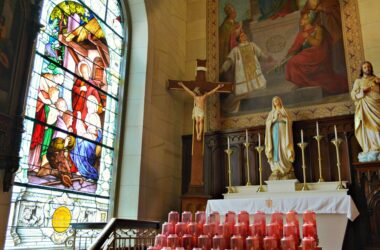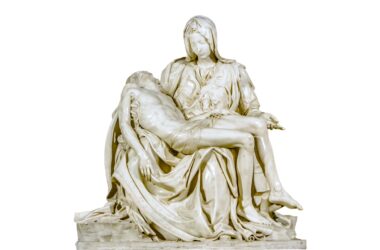What is the Rosary in the Catholic Church?
The Rosary is a cherished form of devotion to Mary, the mother of Jesus, in the Catholic Church. It involves the use of a set of beads, divided into five sections, each consisting of one large bead and ten small ones. On the large bead, the ‘Our Father’ is recited, and on each of the small ones, the ‘Hail Mary’ is said. The ‘Gloria’ is recited between each section or decade. As these prayers are said, one meditates on the joys, sorrows, and glories of Christ’s life and that of His Mother. This practice is deeply rooted in the Catholic tradition and is seen as a beautiful form of prayer. As it is written in Philippians 4:8, “Finally, brothers and sisters, whatever is true, whatever is noble, whatever is right, whatever is pure, whatever is lovely, whatever is admirable—if anything is excellent or praiseworthy—think about such things.”
How does the Rosary connect to the history of Christianity?
The use of beads for prayer dates back to the earliest centuries of Christianity. The prayers incorporated in the Rosary were composed by Christ Himself in the case of the ‘Our Father’, and by the Angel Gabriel, St. Elizabeth, and the Council of Ephesus in the 5th century, in the case of the ‘Hail Mary’. This devotion, with its loving contemplation of the mysteries of the life, death, and resurrection of Our Lord, appeals to rich and poor, to learned and ignorant alike, as Christianity itself was meant to do. As stated in Galatians 3:28, “There is neither Jew nor Gentile, neither slave nor free, nor is there male and female, for you are all one in Christ Jesus.”
What is the symbolism of the Rosary beads?
The symbolism of the Rosary beads is expressed in the word ‘Rosary’ itself. A Rosary is a garland of flowers. Just as one rose does not make a Rosary, a single prayer does not constitute the spiritual life. Prayers are the flowers of the spiritual life, and in offering that group of prayers, known as the Rosary, we lay a garland of spiritual flowers at the feet of God. This is reminiscent of Revelation 8:4, where it is written, “The smoke of the incense, together with the prayers of God’s people, went up before God from the angel’s hand.”
Why is the Rosary a devotion to Mary?
The Rosary is essentially a devotion to Mary, honoring her whom God Himself so honored. It honors her particularly in her relation to Christ, whose life is the subject of the meditations. The ‘Our Father’ abstracts from the incarnation of Christ; the ‘Hail Mary’ is full of reverence to Our Lord’s birth into this world for us. As it is written in Luke 1:28, “The angel went to her and said, ‘Greetings, you who are highly favored! The Lord is with you.'”
How does the repetition in the Rosary relate to Christ’s teachings?
Christ Himself demonstrated the value of repetition in prayer. Just before His passion, Christ prayed “the third time, saying the self-same prayer” (Matthew 26:44). He thought it good to say the same prayer three times in succession. The Rosary follows this principle, with the recitation of ten ‘Hail Marys’ providing sufficient time for reflection on each mystery of the Rosary.
Does the length of the Rosary contradict Scripture’s advice on prayer?
No, Scripture does not advise against long prayers per se. Long hypocritical prayers are condemned, but prayer may be prolonged, as long as it is sincere and heartfelt. Christ said, “We ought always to pray, and not to faint” (Luke 18:1). He himself “went out into a mountain to pray, and he passed the whole night in prayer to God” (Luke 6:12). St. Paul also wrote to the Colossians, “We cease not to pray for you” (Colossians 1:9), and to the Thessalonians, “Night and day we more abundantly pray for you” (1 Thessalonians 3:10).
Please consider supporting us with a PayPal donation
Why is the Rosary composed of vocal prayers?
While short fervent interior prayers are valuable, vocal prayers, when said with due attention and fervor, are equally beneficial and sometimes even better. Christ taught the Apostles a vocal prayer called the ‘Our Father’. They learned it by heart and were able to write it down years later word for word. This shows the significance of vocal prayers in our spiritual life, as stated in Romans 10:10, “For it is with your heart that you believe and are justified, and it is with your mouth that you profess your faith and are saved.”
Why does the Catholic Church omit certain words from the ‘Our Father’?
The Catholic Church omits the words “For thine is the kingdom, the power, and the glory forever and ever” from the ‘Our Father’ because Our Lord did not add those words to the prayer as He taught it. While these words are beautiful in themselves, they are not part of Sacred Scripture. They were added by early Catholic copyists in a margin, and later mistakenly transcribed into the text. As it is written in Deuteronomy 4:2, “Do not add to what I command you and do not subtract from it, but keep the commands of the Lord your God that I give you.”





